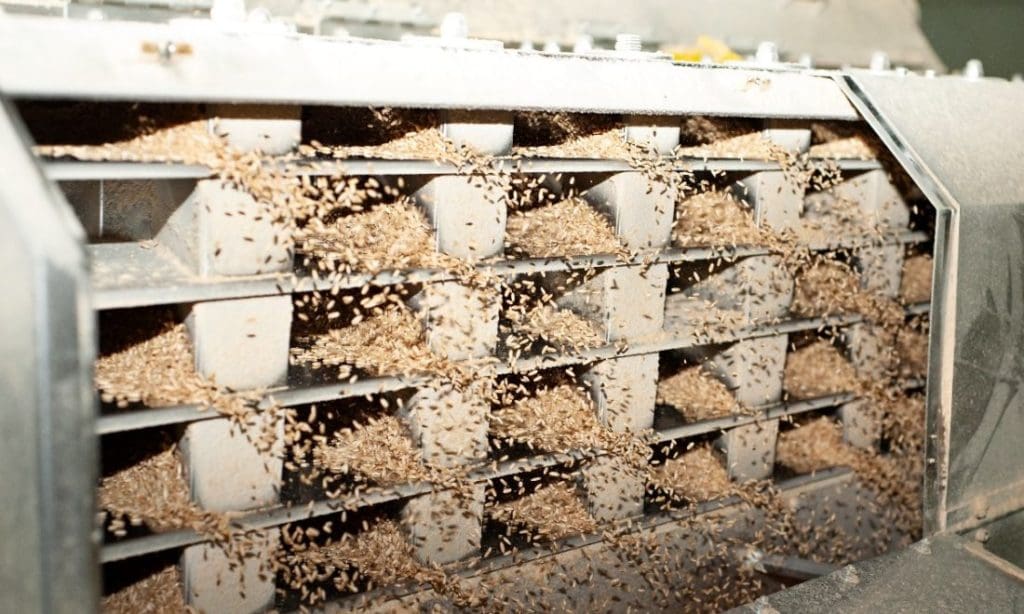
Biogass Renewables project manager Ross Merchant (left) and Blue Lake Milling commercial projects manager Jeremy Neale.
OAT processor Blue Lake Milling has completed construction of its $8.1 million biogas plant at its Bordertown facility in South Australia, and expects it to be using it to supply all its energy needs by next month.
The business is one of Australia’s largest oat processors, and is owned by Western Australia’s CBH Group.
As a 24-hour, five-day-a-week operation, the mill’s current monthly power bill totals about $80,000.
Blue Lake Milling commercial projects manager Jeremy Neale said the plant would generate enough bioenergy to power both the plant and nearby homes.
“Two-thirds of it will go to the mill, and the remaining third will be put back into the grid,” Mr Neale said.
“It’ll go a fair way to eliminating our electricity bill.”
Mr Neale said issues with power reliability first sparked the need for an alternate source more than a decade ago.
“Every time we’ve looked at doing an expansion, power was a limiting factor, so the way around that is to obviously generate your own.”
Mr Neale said the biogas plant would allow manufacturing to continue in the event of an outage.
“Being (located) at the end of the power line, we have a lot of brownouts, so being able to stay powered up and continue operations is a big factor for us; it mitigates against all those risks.”
Established in the 1980s, the Bordertown branch employs 120 people in a town of less than 3000.
The mill processes more than 24,000 tonnes of oat husks each year as a by-product of its production.
Until now, the husks have been sold as stockfeed, used as packing material, or been thrown away.
The mill’s biogas plant converts oat husks into bioenergy through anaerobic digestion, where microorganisms break down biodegradable material into mush which creates biogas.
This mix of methane and carbon dioxide fuels an onsite generator to produce electricity and heat to power the mill.

Hulling oats at Blue Lake Milling’s Bordertown facility.
Long road to generation
In 2017, Blue Lake Milling received a $25,000 grant to undertake an energy efficiency study of its operations and ways to reduce power.
It subsequently developed a proposal for the plant and in 2018 received an additional $20,000 from the South Australian Government to fund a feasibility study.
Following its success, the oat mill secured a further $2.5M in SA Government funding through the Energy Productivity Implementation Grant Program prior to construction starting in 2019.
Biogass Renewables was contracted for the design and will operate and maintain the facility.
While common in Europe, the anaerobic digestion plant is just one of five in Australia, with the vast majority fed by assorted food waste.
To gain a deeper understanding of how to operate a biogas plant, Mr Neale spent two weeks at a workshop in Germany, home to more than 15,000 such facilities.
He said Blue Lake Milling’s ambitious plan was met with scepticism.
“They all told us we were crazy,” Mr Neale said.
“There’s existing plants with oat husks being fed in, but none with it as a straight diet, so it was obviously a bit of a risk.”
Mr Neale said Blue Lake Milling was also drawn to the idea of a biogas plant due to its value as a “renewable and clean” energy source.
“As well as being a more safe and reliable method of generating power, (improving) our environmental footprint and sustainability are things the company is really delving into,” he said.
The branch is in the process of transitioning from gas-powered forklifts to electric models, and is exploring further opportunities to reduce its waste impact.
“We’ll be looking at ways to redirect our landfill to other methods of disposing of waste, so more recycling and anything we can do in that space,” Neale said.
Mr Neale said pioneering such a large-scale project had come with its share of complications.
“The EPA approvals took over a year in themselves,” Neale said.
“There was just no legislative process in place for something like this.”
Appeal of sustainability
Blue Lake Milling CEO Kevin Boyle said that while the new plant would see some business savings, the improvements to sustainability were what got the project over the line.
“The return on investment in financial terms actually remains very low,” Mr Boyle said.
“For businesses like ours, if it was only a financial decision, we would likely not commit to it.
“This is a representation of the values of our whole organisation, this is real leadership in industry, and planning for a better future.”
Regional Development Australia Limestone Coast (RDALC) administered the State Government’s Bioenergy Roadmap Program, which funded the feasibility study for the plant.
RDALC deputy chair Alan Richardson said the project exemplified the environmental and economic benefits of bioenergy solutions.
“We’ve got these fabulous resources of bioenergy in the Limestone Coast, in particular the forestry and agriculture industries, and it’s really been wasted until now,” Richardson said.
“In some cases, excess (biomatter) is being burnt, which is bad for the environment.
“This is making the best use of a local resource.”
Blue Lake Milling has its origins in Mount Gambier, and first milled oats in 1875.
By the 1980s, the business had expanded to its current site at Bordertown to give it better proximity to grain-growing districts.
In 2015, Blue Lake Milling transitioned from family to cooperative ownership when it was bought by CBH Group, which will use the Bordertown project to gauge potential for similar systems at its other grain operations throughout the country.
Source: The Lead, Blue Lake Milling



HAVE YOUR SAY